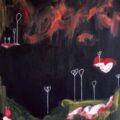What do I know of drowning? On Matt W. Miller’s The Wounded for the Water
“I lie and clinging to the art / of each other’s lies we choke down beers.”
Matt W. Miller’s latest collection, The Wounded for the Water (Salmon Poetry, 2018) opens with a preface poem that reads like a lonely sea shanty, a solitary voice singing: “Now to chart a way / of skinning waves … Now to slice beneath the bloom / of blue … Now to be sewn in foam / and still to breathe … Now to stitch across / all my definitions of drown.” The poem, like the book, renders masculinity visible in a setting of many waters—and with the collection’s refrain: What does it mean to drown?
Miller plunges the surface of literal and metaphorical drowning with honesty, humility, and candor. He confronts the struggle to be man and mortal via water’s mythic freight, and there is something to be said about the decline of white man as the genderless personhood—Miller instead examines how gender, sexuality, class, and race shapes his particular identity. In recapturing events that span a lifetime, Miller reflects on his path from boy to man in the modern world.
“Ordeal by Water,” a sequence of narratives, recounts a history of masculinity as it is put to ritual and physical tests. The speaker recalls his father throwing him into a Miami pool and demanding that the four-year old “swim to the other side”—a father/son lesson in how “not to drown,” and also perhaps the first exposure the speaker has to the cultural script of masculinity. To be biologically male is one thing, to become one of the boys is a status that must be achieved through self-reliance and the sacrifice of emotional needs.
These trials by water continue throughout the collection, from a close call while surfing to a barroom encounter with an old high school friend—a “fellow football captain” who “once popped his dislocated shoulder back into his socket between downs” and who, during their brief encounter, describes beating an inmate at his job as a prison guard. The poem is a canny example of obligatory male social performance, the suffocation of emotional withholding: “We slip below the surface, a smile curling up toward tears we can’t allow… He laughs and I laugh. You good? he asks. / Yeah, I’m good. I lie and clinging to the art / of each other’s lies we choke down beers.”
What does it mean to drown?
A gifted storyteller, Miller twirls poems of lyrical beauty with poems of matter-of-fact colloquialisms. He takes the reader from “I carve oxygen from a spray of foam” to “A witch’s tit Tuesday night, and I am on dorm duty.” Miller’s collection contains all the power and pathos of an unexceptional life, but these poems are more than anecdotes and epiphanies. A more controlled hand is at work here, one that uses poetry to make sense of the self, to connect individual stories with a larger narrative. “I spin words not knowing that I cannot see the wounded for the water. / There are bodies drowning all around me…”
In this tension between lyric and salt-of-the-earth, Miller’s many definitions of drowning are stitched together. Drowning, after all, can be waterless: “We drown inland … The kind of drowning that picks fights with mothers, lovers, cops / and all the friends I murdered into strangers.” It can be the helplessness of losing a newborn: “My Daughter is born drowning, choking / on blood and amniotic fluid caught in her throat / as I stand dumb”. It can be a parent’s mortality, “…the stench of Dad’s dead man’s / chest, of his bile leaking gut… what do I know of drowning / but that I drown dumbly in their thousand / furlongs of tears, of blood, of bile—quiet / as a breath that will not come.”
While Miller doesn’t seem to embrace the idea of Robert Bly’s mythopoetic man, the poems in Wounded for the Water are packed with allusions to the Bible, ancient classics, and 17th-Century epics. It would be surprising if the idea of heroic archetypes for men and ritual male bonding had not occurred to the poet. Several references that draw from Shakespeare, for instance, leverage a common Elizabethan trope: women, foreigners, and social unequals establish respectable masculine identities through contrast. Take for instance, the poem title taken from Henry V, “Shall the Good Man Teach:”
…all over the news:
big men, big as the abstraction of barbarian
invasions, are blitzing their thickened thumbs
toward each other, calling each other faggot
and bully, nigger and redneck. Their tweets
are the birdsongs mouse might hear before
shrike spears him on the thorns. Media pimps
debate between what’s a punch, what’s a tickle.
So the mean of pro linemen becomes a headline
about man’s measure in a land where the rituals
to manhood are boys martyred on six man sleds
on August afternoons. Who here’s a hero and what
makes a coward lathers in the tailgates, on call-in
talk shows, in locker rooms, in the proud quiet
between fathers and sons on Friday night truck rides
home from last play wins under thousand watt lights.
Miller toes a fine line in nodding to these familiar pillars of antiquity. The constructions of male identity in these texts have influenced men for centuries—but especially over the past century—and denying the importance of these ideals, however dysfunctional, would strip the poems of their authenticity and insight. Miller volleys with but doesn’t embody these ideas. The poet is not Prince Hamlet after all, nor claims to be, as Eliot’s Prufrock would say. (Short-hemmed, neurotic Prufrock gets a nod from Miller as well, “We drown as well inside the human voice that wakes us / then breaks us upon the rocks.”)
Family and social roles have been in a process of re-evaluation for decades, a revision of sources and resource—cultural, social, moral, economic, political. The Wounded for the Water is grounded in this awareness. To the many questions that his poems raise, Miller resists a definitive answer. The growth of the human soul is shaped by the solitary movements of life, he observes, and by the inevitability of death.
Blond, blue-eyed boys
of the world, confess
our sad bones to each other—
do not be conscripts
to miracles of hate. You must
know our handsome
is a lie, a confusion of place,
of time, of the eye—
nothing but a pop fly lost
in the sun, suddenly caught
in a stiff leather mitt,
by a blind stab at the sky.
In his poem, “The Way It Is,” William Stafford notes that there is a thread that you follow through your life. As long as you keep hold of that thread you won’t get lost. In The Wounded for the Water, that connection is a deep unknown. It swirls above our heads, “a taking back of drowning, a wash of drowning in new definitions… a drowning that saves, heals, that allows you to keep company with hope, makes you start swimming.”
About Kate Hanson Foster
Kate Hanson Foster’s first book of poems, Mid Drift, was published by Loom Press and was a finalist for the Massachusetts Center for the Book Award in 2011. Her work has appeared in Comstock Review, Harpur Palate, Poet Lore, Salamander, Tupelo Quarterly, Five:2:One Magazine, and elsewhere. She was recently awarded the NEA Parent Fellowship through the Vermont Studio Center.





